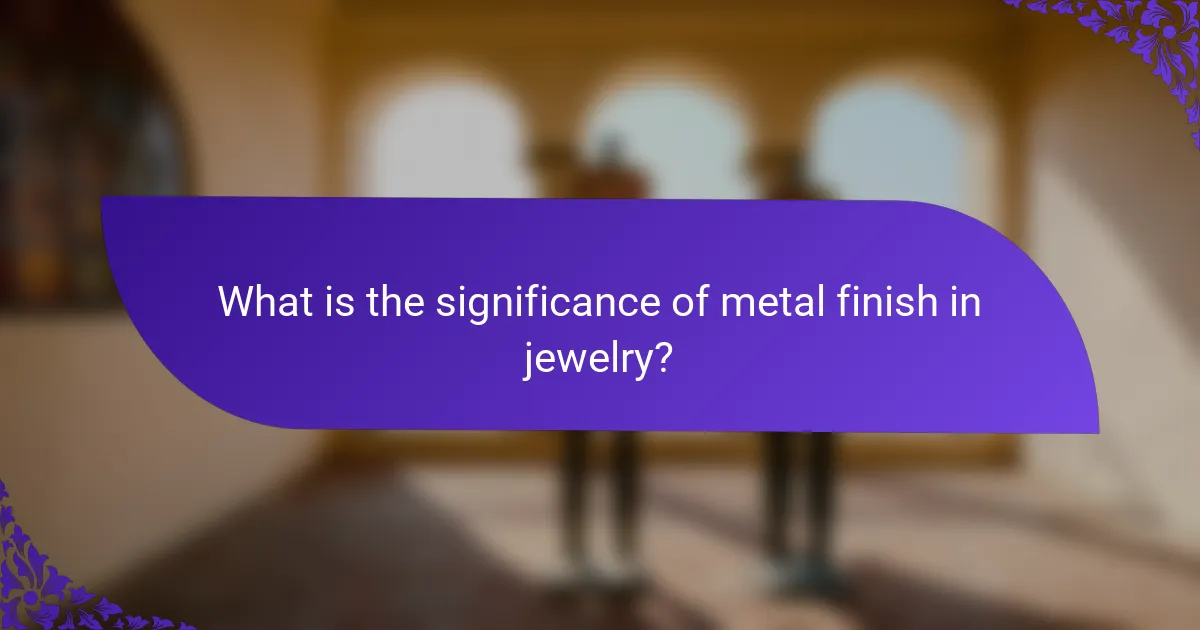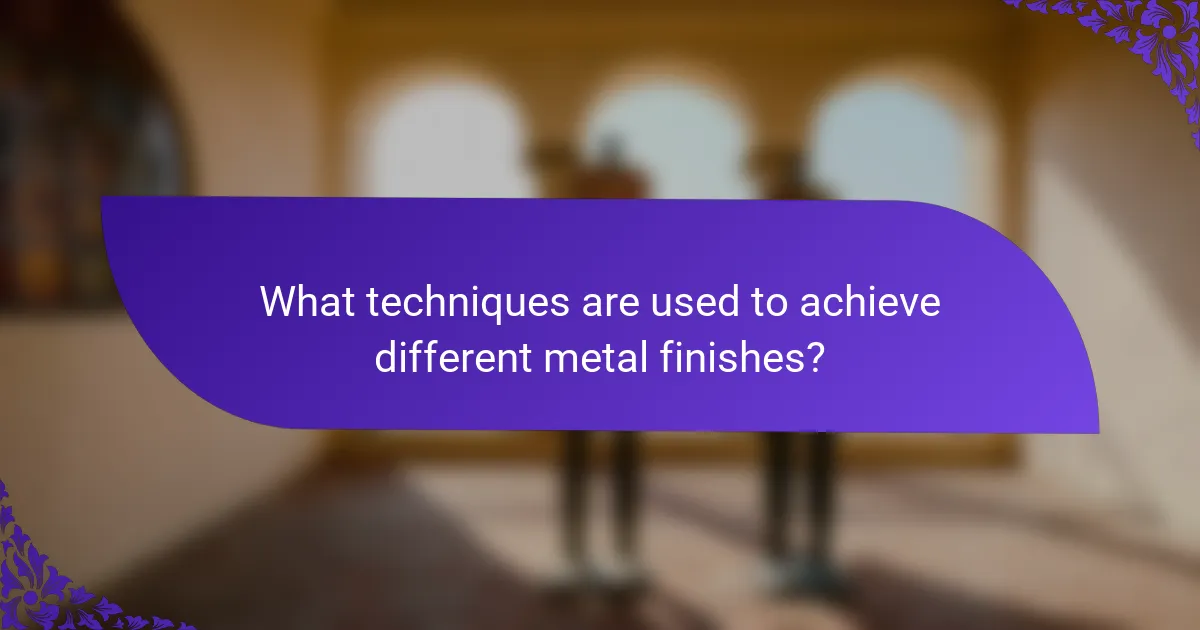Metal finish is a crucial aspect of jewelry that influences both its aesthetic appeal and durability. Various finishes, including polished, matte, and brushed, create distinct visual effects and affect consumer preferences. The article examines different techniques used to achieve these finishes, such as polishing, sandblasting, anodizing, electroplating, and chemical patination, each with specific applications and effects. Additionally, it highlights the maintenance requirements for each type of finish to preserve appearance and longevity, emphasizing the importance of proper care to prevent deterioration and extend the life of jewelry pieces.

What is the significance of metal finish in jewelry?
Metal finish in jewelry significantly affects its aesthetic appeal and durability. Different finishes, such as polished, matte, or brushed, create distinct visual effects. Polished finishes reflect light, enhancing brilliance. Matte finishes provide a subtle, elegant look. Brushed finishes add texture and depth. The choice of finish can influence consumer preferences and perceived value. Additionally, finishes can protect the underlying metal from tarnish and wear. For example, rhodium plating is often used to enhance white gold jewelry’s shine and longevity. The significance of metal finish extends beyond appearance; it impacts maintenance and care requirements as well.
How does metal finish impact the overall quality of jewelry?
Metal finish significantly impacts the overall quality of jewelry. A high-quality metal finish enhances the aesthetic appeal and durability of the piece. Polished finishes reflect light effectively, giving jewelry a brilliant shine. Matte finishes provide a subtle, modern look while hiding scratches better. Textured finishes can add depth and uniqueness to designs. The type of finish also affects corrosion resistance. For example, rhodium plating can protect white gold from tarnishing. Quality metal finishes contribute to the longevity and wearability of jewelry items.
What are the different types of metal finishes used in jewelry making?
There are several types of metal finishes used in jewelry making. Polished finish is smooth and reflective, enhancing the metal’s natural shine. Matte finish has a non-reflective surface, offering a subtle and understated look. Brushed finish features fine lines or textures, creating a soft appearance. Antiqued finish gives a vintage or aged look by darkening recesses. Hammered finish includes irregular textures from hammering, adding character and uniqueness. Oxidized finish darkens the metal for a dramatic effect, often highlighting details. Each finish serves aesthetic purposes and can influence the overall design of the jewelry piece.
How do various metal finishes affect durability and wear?
Various metal finishes significantly impact durability and wear. Polished finishes tend to be more susceptible to scratches and tarnishing. In contrast, brushed finishes offer better resistance to wear due to their texture. Anodized finishes on aluminum enhance corrosion resistance, prolonging the lifespan of the metal. Galvanized finishes provide a protective zinc layer, which helps prevent rust. Additionally, electroplated finishes can vary in thickness, affecting their durability; thicker layers generally offer better protection. Research indicates that the choice of finish directly influences the longevity of jewelry pieces. For instance, a study by the Jewelry Industry Council found that properly finished pieces can last up to five times longer than poorly finished ones.
Why is metal finish important for aesthetic appeal?
Metal finish is crucial for aesthetic appeal because it directly influences the visual quality and attractiveness of jewelry. A well-executed finish enhances the surface texture and shine, making the piece more appealing to the eye. Different finishes, such as polished, matte, or brushed, create distinct looks that can evoke various styles and emotions. For example, a polished finish reflects light beautifully, adding a luxurious feel. Conversely, a matte finish can impart a modern and understated elegance. Additionally, the choice of finish can highlight intricate details and craftsmanship, drawing attention to the design elements. Ultimately, the right metal finish contributes significantly to a jewelry piece’s overall aesthetic value and marketability.
What role does metal finish play in the visual characteristics of jewelry?
Metal finish significantly influences the visual characteristics of jewelry. It determines the texture, shine, and overall appearance of the piece. Different finishes, such as polished, matte, or brushed, create distinct visual effects. A polished finish reflects light, enhancing brilliance and making the jewelry appear more vibrant. In contrast, a matte finish absorbs light, offering a subtle and understated look. Additionally, finishes can highlight design details and craftsmanship. For instance, a textured finish can add depth and interest to a simple design. Overall, the choice of metal finish plays a crucial role in the aesthetic appeal and style of jewelry.
How do different finishes enhance or diminish the value of a piece?
Different finishes can significantly enhance or diminish the value of a jewelry piece. A high-polish finish often increases perceived value by providing a reflective quality that highlights craftsmanship. In contrast, a matte finish may convey a modern aesthetic but can reduce the perceived value due to less visual appeal. Textured finishes can add uniqueness and character, potentially elevating value if they align with current trends. Conversely, poorly executed finishes can detract from value by suggesting lower quality or craftsmanship. Historical context shows that finishes like rhodium plating can enhance durability and shine, thus increasing value. Ultimately, the finish must complement the design and materials for maximum value impact.

What techniques are used to achieve different metal finishes?
Different techniques are used to achieve various metal finishes. Common techniques include polishing, which creates a smooth, reflective surface. Sandblasting produces a matte finish by using abrasive particles. Anodizing enhances corrosion resistance and adds color through an electrochemical process. Electroplating deposits a thin layer of metal onto the surface for both aesthetic and protective purposes. Chemical patination alters the metal surface color through chemical reactions. Each technique has specific applications and effects on the final appearance of the metal.
What are the most common techniques for applying metal finishes?
The most common techniques for applying metal finishes include polishing, plating, anodizing, and powder coating. Polishing enhances the metal’s shine by removing surface imperfections. This technique often uses abrasive materials to achieve a smooth surface. Plating involves depositing a layer of metal onto the surface for aesthetic or protective purposes. Gold and silver plating are popular in jewelry to enhance appearance and prevent tarnishing. Anodizing is an electrochemical process that thickens the natural oxide layer on metals like aluminum. This technique provides corrosion resistance and allows for dyeing in various colors. Powder coating applies a dry powder that is cured under heat, creating a durable finish. This method is often used for its resistance to chipping and fading. Each technique serves specific purposes in enhancing both the aesthetics and durability of metal jewelry.
How does polishing differ from plating in jewelry finishing?
Polishing and plating are distinct processes in jewelry finishing. Polishing enhances the surface shine and smoothness of the metal. It involves removing a thin layer of material to eliminate scratches and imperfections. This process can be performed using various tools and compounds, resulting in a reflective surface.
Plating, on the other hand, involves applying a thin layer of metal onto the surface of the jewelry. This is usually done for aesthetic purposes or to provide a protective coating. Common plating metals include gold, silver, and rhodium. The plating process often uses electrolysis or chemical deposition to bond the new metal to the base material.
In summary, polishing improves the existing surface, while plating adds a new layer of metal. Both techniques serve different purposes in jewelry finishing, contributing to the overall appearance and durability of the piece.
What are the effects of texturing and engraving on metal finishes?
Texturing and engraving significantly alter metal finishes. Texturing creates a tactile surface that enhances light reflection. This results in a more dynamic appearance. Engraving adds intricate designs, which can personalize the piece. Both techniques can increase the perceived value of jewelry. They also affect the durability of the metal finish. Textured surfaces may hide scratches better than smooth finishes. Engraved areas can be prone to wear if not maintained properly.
How do artisans choose the right technique for a specific piece?
Artisans choose the right technique for a specific piece by assessing the design requirements and material properties. They consider the desired aesthetic outcome, such as texture and shine. The functionality of the piece also influences the choice of technique. For example, a highly polished finish may be suitable for a decorative item. In contrast, a matte finish might be better for functional jewelry that requires durability. Artisans often rely on their experience and knowledge of various techniques, such as electroplating or hand polishing. Additionally, they may experiment with different methods to achieve the best result. Ultimately, the choice is guided by the balance between artistic vision and practical considerations.
What factors influence the selection of finishing techniques in jewelry design?
The selection of finishing techniques in jewelry design is influenced by several key factors. These factors include the type of metal used, the desired aesthetic effect, and the intended use of the jewelry piece. Different metals react uniquely to finishing techniques, affecting durability and appearance. For instance, softer metals like gold may require gentler techniques to avoid damage.
The desired aesthetic effect plays a crucial role, as techniques can range from high polish to matte finishes. Each finish imparts a distinct look, impacting consumer preferences. Additionally, the intended use of the jewelry affects technique selection. Pieces meant for everyday wear may prioritize durability over aesthetics, leading to different finishing choices.
Market trends and consumer demand also influence finishing techniques. Designers often adapt to popular styles, ensuring their work aligns with current tastes. Finally, the skill level of the jeweler can determine which techniques are feasible, impacting the final selection.
How does the choice of metal affect finishing techniques?
The choice of metal significantly influences finishing techniques in jewelry. Different metals have varying properties that dictate the appropriate finishing methods. For example, softer metals like gold and silver can be polished to a high shine more easily than harder metals like titanium or stainless steel.
Additionally, the surface characteristics of metals affect the choice of abrasives and polishing compounds. Certain metals require specific techniques to avoid damage or undesirable results. For instance, aluminum may oxidize if not finished properly, necessitating protective coatings after polishing.
Moreover, the desired aesthetic also plays a role. Matte finishes may be preferred on some metals for a contemporary look, while others may benefit from a high-gloss finish to enhance their luster.
Overall, understanding the metal type allows artisans to select suitable tools and methods, ensuring the best possible finish while preserving the integrity of the material.

What maintenance is required for different metal finishes?
Different metal finishes require specific maintenance to preserve their appearance and longevity. Polished metals, like silver and gold, need regular cleaning with a soft cloth to remove tarnish. Matte finishes, such as brushed metal, require gentle wiping to avoid scratches. Oxidized finishes should be cleaned with a damp cloth and avoid harsh chemicals. Electroplated metals need protection from moisture and should be stored in a dry place. Each finish’s unique characteristics dictate its care requirements to maintain its aesthetic appeal. Regular maintenance prevents deterioration and extends the life of jewelry pieces.
How can jewelry owners care for their finished pieces?
Jewelry owners can care for their finished pieces by regularly cleaning them. Use a soft cloth to wipe away dirt and oils after each wear. Avoid exposing jewelry to harsh chemicals, including household cleaners. Store pieces in a dry, cool place, preferably in a jewelry box or pouch. Separate different types of jewelry to prevent scratching. Periodically inspect for loose stones or damages. If needed, seek professional cleaning and maintenance. Following these practices can prolong the life and appearance of jewelry.
What are the best practices for cleaning and maintaining metal finishes?
To clean and maintain metal finishes, use a soft cloth and mild soap solution. This method effectively removes dirt and oils without damaging the finish. Rinse the metal with clean water after washing to avoid soap residue. For tarnished metals, apply a specialized metal polish according to the manufacturer’s instructions. Avoid abrasive cleaners, as they can scratch the surface. Regularly inspect metal items for signs of wear or damage. Store metal jewelry in a dry, cool place to prevent oxidation. These practices help preserve the appearance and longevity of metal finishes.
How can exposure to elements affect the longevity of metal finishes?
Exposure to elements can significantly reduce the longevity of metal finishes. Factors such as moisture, humidity, and temperature fluctuations can lead to corrosion and tarnishing. For instance, saltwater can accelerate rust formation on iron finishes. Similarly, UV radiation can degrade protective coatings, leading to discoloration. Metals like silver tarnish when exposed to sulfur compounds in the air. Regular maintenance and protective coatings can mitigate these effects. Studies indicate that metals treated with appropriate sealants last longer in harsh environments.
What are common issues with metal finishes and how can they be resolved?
Common issues with metal finishes include tarnishing, scratching, and discoloration. Tarnishing occurs due to oxidation when metals like silver are exposed to air and moisture. This can be resolved by regularly polishing the metal with appropriate cleaners designed for specific metals. Scratching results from contact with harder surfaces or rough handling. To minimize scratches, use soft cloths for cleaning and store jewelry separately. Discoloration may arise from exposure to chemicals or prolonged wear. This can be addressed by avoiding contact with lotions and perfumes and cleaning the jewelry after use. Regular maintenance and proper storage can significantly extend the life of metal finishes.
What signs indicate that a metal finish needs restoration?
Signs that indicate a metal finish needs restoration include visible scratches or dents on the surface. These imperfections can disrupt the aesthetic appeal of the metal. Discoloration or tarnishing is another sign, as it suggests oxidation or chemical reactions. If the metal appears dull or lacks luster, it may require polishing or refinishing. Additionally, if there are signs of corrosion, such as rust, immediate restoration is necessary to prevent further damage. Lastly, if the metal finish is flaking or peeling, it indicates a breakdown of the protective layer and requires urgent attention. These signs collectively indicate that the metal finish is compromised and needs restoration to maintain its appearance and integrity.
How can jewelry be restored to its original finish?
Jewelry can be restored to its original finish through cleaning, polishing, and refinishing techniques. First, clean the jewelry with a gentle soap solution to remove dirt and oils. Next, use a polishing cloth to buff the surface, enhancing its shine. For deeper scratches or tarnish, consider using a metal polish specifically designed for the type of metal. If necessary, professional jewelers can refinish the piece by reapplying the original plating or using specialized tools. These methods effectively restore the jewelry’s appearance and maintain its value.
What tips can help maintain the beauty of metal finishes in jewelry?
To maintain the beauty of metal finishes in jewelry, regularly clean the pieces with a soft, lint-free cloth. This removes dirt and oils that can dull the surface. Store jewelry in a cool, dry place, preferably in a fabric-lined box to prevent scratches. Avoid exposure to harsh chemicals found in household cleaners, as they can damage the finish. Remove jewelry before swimming or bathing to protect against chlorine and saltwater. Use anti-tarnish strips in storage to minimize tarnishing. For deeper cleaning, use a gentle soap solution and rinse thoroughly. Regular maintenance helps preserve the luster and integrity of the metal finishes.
The main entity of this article is metal finish in jewelry, which plays a critical role in determining the aesthetic appeal, durability, and perceived value of jewelry pieces. The article explores various types of metal finishes, including polished, matte, brushed, and textured, detailing their impact on visual characteristics and maintenance requirements. It also examines techniques for achieving these finishes, such as polishing, plating, and anodizing, while highlighting the importance of selecting appropriate methods based on metal type and design intent. Additionally, the article addresses best practices for maintaining metal finishes to ensure longevity and preserve the beauty of jewelry.


